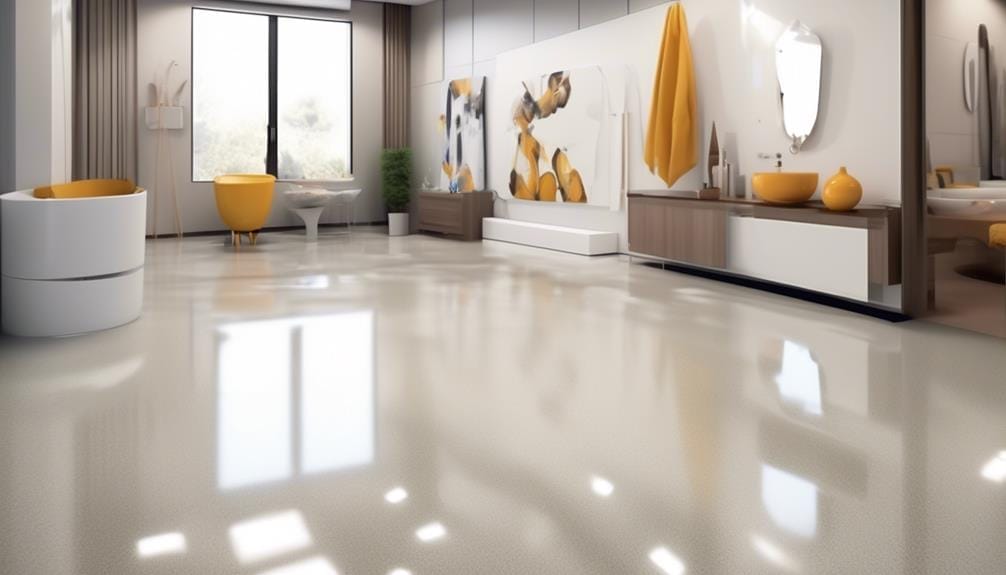Are you tired of dealing with uneven and rough surfaces? Have you ever wished for a solution that can effortlessly transform your floors or countertops into a flawless and glossy finish? Look no further, because self-leveling epoxy is here to save the day.
This incredible coating not only levels itself out, but also offers water resistance, durability, and a stunning glossy appearance. But wait, there's more to discover.
So, get ready to explore the benefits, application techniques, and maintenance tips of self-leveling epoxy. You won't want to miss out on this game-changing solution for achieving a seamless and attractive surface.
Key Takeaways
- Self-leveling epoxy provides a seamless and uniform surface, eliminating the need for joints and cracks.
- It offers outstanding performance and high-impact resistance, making it durable and long-lasting.
- Self-leveling epoxy is highly resistant to scratching and abrasion, ensuring a resilient and low-maintenance surface.
- It can be used on various surfaces such as wood, concrete, and metal, allowing for versatile application options.
Benefits of Self-Leveling Epoxy
What are the advantages of using self-leveling epoxy for your flooring needs?
Self-leveling epoxy offers a multitude of benefits that make it an ideal choice for various flooring applications.
One major advantage of self-leveling epoxy is its ability to provide a seamless and uniform surface, which eliminates the need for joints and cracks that can collect dirt and bacteria. This makes it a hygienic option for commercial and industrial settings.
Additionally, self-leveling epoxy serves as a protective coating, offering outstanding performance and high-impact resistance. It's highly resistant to scratching and abrasion, ensuring the longevity of your flooring.
Another benefit of self-leveling epoxy is its versatility. It can be used on a variety of surfaces, including wood, concrete, and metal, providing a hard and durable surface suitable for heavy use.
Furthermore, self-leveling epoxy can act as a substrate for other floor coatings, allowing for a wide range of aesthetic options.
Whether you're looking to resurface worn flooring or create a visually appealing environment, self-leveling epoxy is an excellent choice due to its numerous benefits.
How to Prepare the Surface for Self-Leveling Epoxy
To prepare the surface for self-leveling epoxy, it's crucial to thoroughly clean the surface, removing all dirt, dust, and debris. Any contaminants left on the surface can hinder the adhesion of the self-leveling epoxy, leading to an uneven finish. Start by sweeping or vacuuming the surface to remove loose debris. Use a mild detergent, warm water, and a scrub brush to clean the surface, paying extra attention to any stubborn stains. Rinse thoroughly and allow the surface to dry completely.
In addition to cleaning, it's important to address any cracks, holes, or uneven areas in the surface before applying the self-leveling epoxy. Fill in any gaps with a suitable filler and smooth it out to create a level base. This will ensure that the self-leveling epoxy can properly level out and create a seamless finish.
If the surface is porous, such as concrete, it's recommended to apply an epoxy primer before applying the self-leveling epoxy. The primer will seal the surface and provide a better bonding surface for the self-leveling epoxy. Follow the manufacturer's instructions for the primer application, including drying time, before proceeding with the self-leveling epoxy.
Step-By-Step Guide to Applying Self-Leveling Epoxy

To apply self-leveling epoxy, you'll need to follow a step-by-step process that ensures proper adhesion and a seamless finish. Here is a guide to help you through the application process:
- Prepare the substrate:
Thoroughly clean and prepare the surface by removing any dirt, grease, or loose particles. Repair any cracks or imperfections on the surface to ensure a smooth and even application.
- Prime the substrate:
Apply a coat of Perdure E02, a 100% solids epoxy primer, to the prepared surface. This primer will enhance adhesion and promote a strong bond between the substrate and the self-leveling epoxy.
- Install a body coat:
Mix Perdure E10 with self-leveling aggregates according to the manufacturer's instructions. Apply this mixture to the primed surface to create a smooth and level base for the self-leveling epoxy.
- Apply the self-leveling epoxy:
Pour the self-leveling epoxy onto the prepared surface and use a squeegee or roller to spread it evenly. The epoxy will self-level, filling in any low spots or imperfections on the surface.
- Finish with a topcoat:
Once the self-leveling epoxy has cured, apply a coat of Perdure E20 pigmented epoxy coating for added durability and a professional finish. Finish the project with a topcoat of polyurethane or polyaspartic top coat for enhanced protection.
Tips for Achieving a Flawless Finish With Self-Leveling Epoxy
For a flawless finish with self-leveling epoxy, it is crucial to thoroughly prepare the substrate, ensuring a smooth and even surface. This step is essential because any imperfections or irregularities in the substrate can be magnified once the epoxy is applied. To help you achieve the best results, here are some tips to consider:
| Tips for Achieving a Flawless Finish With Self-Leveling Epoxy |
|---|
| Properly mix the resin and hardener for at least 5 minutes to avoid air bubbles. |
| Protect floors and furniture with plastic sheets during application to prevent contamination. |
| Use rollers specifically designed for epoxy to achieve an even application and avoid using lint-free or foam rollers. |
| Research the process thoroughly and test the epoxy on a small piece before applying it to a larger surface for optimal results. |
Maintenance and Care for Self-Leveling Epoxy Floors

After achieving a flawless finish with self-leveling epoxy by following the previous tips, it's important to properly maintain and care for your epoxy floors to ensure their longevity and durability. Here are some key maintenance and care practices for self-leveling epoxy floors:
- Regular Cleaning:
- Sweeping or vacuuming the floor on a regular basis helps remove dirt and debris that can scratch or dull the surface of the epoxy.
- Cleaning the floor with a mild detergent and water solution will help maintain its glossy finish without causing any damage.
- Protective Measures:
- Avoid using harsh chemicals or abrasive cleaners on the epoxy surface, as they can strip away the protective layer and cause damage to the floor.
- Placing protective pads on furniture legs will prevent scratches and dents on the epoxy floor when moving or rearranging furniture.
- Periodic Inspections:
- It's important to periodically inspect the epoxy floor for any signs of wear or damage, such as cracks or peeling.
- Addressing these issues promptly will help maintain the durability of the floor and prevent further damage.
Frequently Asked Questions
Is There a Self-Leveling Epoxy?
Yes, there is a self-leveling epoxy available. It offers many advantages such as seamless and durable flooring. When applying, make sure to follow application tips and DIY techniques for a successful installation.
How Thick Can You Pour Self-Leveling Epoxy?
You can pour self-leveling epoxy to a thickness of 1/8 inch. It has self-leveling properties, meaning it will spread out evenly. Before pouring, make sure to prepare the surface properly.
Is Self-Leveling Epoxy Expensive?
Self-leveling epoxy can be expensive, but it offers numerous benefits and applications. Consider the pros and cons, long-term durability, and potential savings. Don't forget about the additional expenses like surface preparation and topcoat materials.
How Much Does Self Levelling Epoxy Cost?
Self-leveling epoxy can vary in cost depending on factors such as type, brand, and coverage area. Prices range from $30 to $100 per gallon, with additional costs for primer, pigmented coatings, topcoats, and aggregate.
Conclusion
In conclusion, self-leveling epoxy is a reliable and versatile solution for creating seamless and attractive surfaces. Its benefits, such as water resistance, durability, and a glossy finish, make it an ideal choice for various applications.
However, it's important to carefully prepare the surface and follow a step-by-step application process to achieve a flawless finish.
With proper maintenance and care, self-leveling epoxy floors can maintain their beauty and functionality for a long time.
So, go ahead and give your surfaces a stunning upgrade with self-leveling epoxy!





